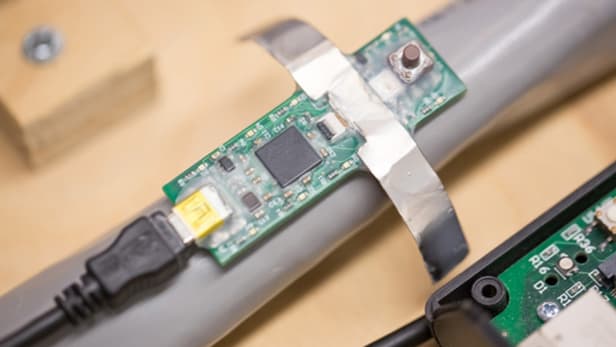
Accurately tracking energy usage in the home is a problem that numerous researchers and startups have taken a pass at. Devices like the Neurio sensor and the MeterPlug could, when hooked up to the breaker panel or the AC outlets, send notifications to the user alerting them to their home electricity usage.
There have also been attempts to take electricity-monitoring technology wireless, most recently with MagnifiSense, a wrist-worn prototype that monitors appliances the wearer interacts with throughout the day by tracking their individual electromagnetic signatures. But researchers at MIT are now claiming to have overcome one of the problems with this wireless monitoring approach, where the magnetic fields emanating from devices and wires can cancel each other out.
The system uses an array of five sensors that are set slightly apart from each other on the incoming power line, which they can be attached to with a zip tie. This negates the need for numerous sensors to be placed on outlets around the home, as is the case with some existing monitoring systems. Purpose-built calibration software is able to track readings from each of the sensors and determine which is best positioned to get the strongest signal.
According to the MIT team, every motor or device in the home gives off a specific signature, pertaining to how much the voltage varies and spikes when the device is switched on and operating. It has built up a catalog of these signatures, which allows the system's advanced software to distinguish between each electrical load.
It is just a prototype at the moment, but MIT says that the data collected by such a device could be presented through customized apps. It could even be detailed enough to cater to specific needs or interests, and allow users to focus on particular time segments, such as when a refrigerator goes into defrost mode, or how often a water heater goes on and off throughout the day.
The researchers say that testing the system at a military training base helped uncover a large amount of fuel and money going to waste. The installation showed that large tents were being heated all day during the winter even when unoccupied (you'd think this type of energy wastage would be kind of obvious, but hey, never hurts to know the specifics).
Another test installation in a home revealed a dodgy wiring flaw that was loading up copper plumbing pipes with an electrical current, suggesting an energy tracking system like this could carry some safety benefits, too.
There's no mention of when it might happen, but if the system does evolve into a commercial product the researchers imagine it would cost no more than US$25 to $35 to install per home.

 Previous page
Previous page Back to top
Back to top







